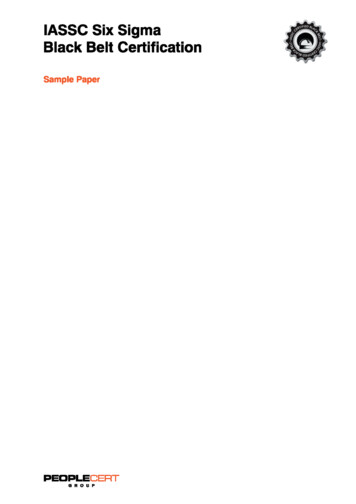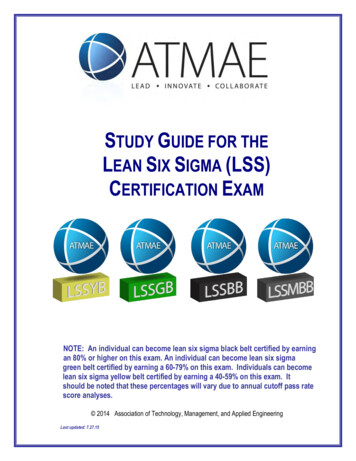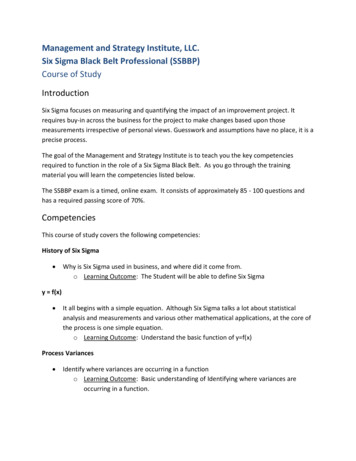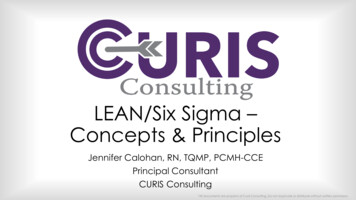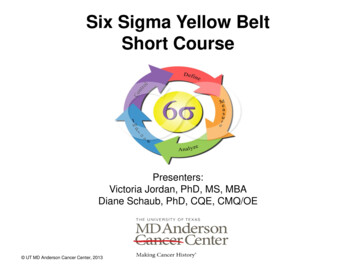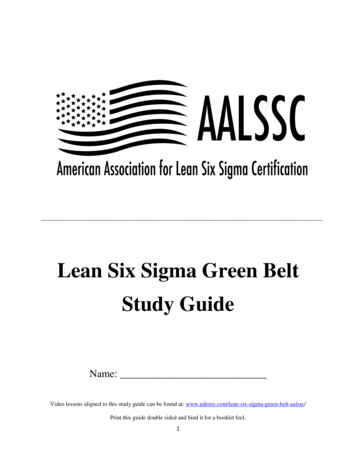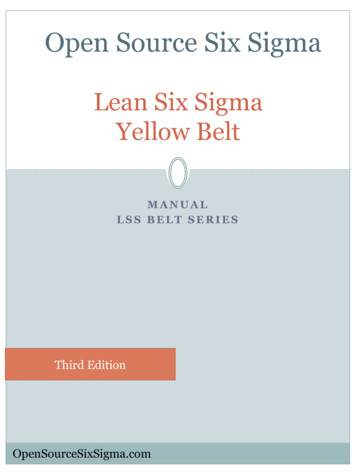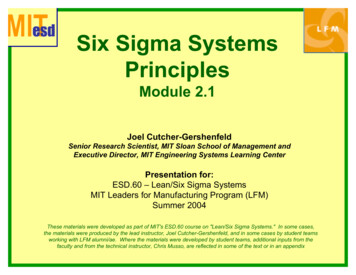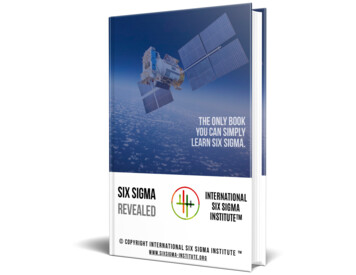
Transcription
SIX SIGMAREVEALEDTRAINING BOOKSECOND EDITIONBY INTERNATIONAL SIX SIGMA INSTITUTE www.sixsigma-institute.org COPYRIGHT INTERNATIONAL SIX SIGMA INSTITUTE
DedicationTo all of the International Six Sigma Institute students, thank you for inspiring us, keepingus focused, and making sure we do our best to help you grow in your career with your skillsand knowhow. Without you, your engagement and your loyal support, International SixSigma Institute could not come where it is today.
TABLE OF CONTENTSCLICKABLEWELCOME .8ABOUT INTERNATIONAL SIX SIGMA INSTITUTE .9What is Six Sigma? .10What is Quality? .12What is the Hidden Factory? .13Six Sigma Process Excellence Disciplines .14History of Six Sigma .16How does Six Sigma work? .17What is Sigma and Why is it Six Sigma? .19What is the Focus of Six Sigma? .23How does Six Sigma DMAIC Process work? .25Six Sigma Roles and Responsibilities .28Six Sigma vs Business Process Reengineering (BPR) - A Comparison .35
What is Statistics? .37What is Descriptive Statistics? .38What is Inferential Statistics? .42Accuracy vs Precision .43Six Sigma DMAIC Process - Introduction to Define Phase .44Six Sigma DMAIC Process - Introduction to Measure Phase .45Six Sigma DMAIC Process - Introduction to Analyze Phase .46Six Sigma DMAIC Process - Introduction to Improve Phase .47Six Sigma DMAIC Process - Introduction to Control Phase .48Six Sigma DMAIC Process - A Real World Example.49Six Sigma DMAIC Process - Define Phase - Capturing Voice of Customer (VOC) .50Six Sigma DMAIC Process - Define Phase - KANO Analysis .53Six Sigma DMAIC Process - Define Phase - CTQ Drilldown Tree .55Six Sigma DMAIC Process - Define Phase - Six Sigma Project Charter .56Six Sigma DMAIC Process - Define Phase - Change Acceleration Process (CAP) .60Six Sigma DMAIC Process - Define Phase - Process Mapping / SIPOC .64
Six Sigma DMAIC Process - Define Phase - Process Mapping / Flow Charting .65Six Sigma DMAIC Process - Measure Phase - Identify Possible Project Y's .67Six Sigma DMAIC Process - Measure Phase - Types of Data .68Six Sigma DMAIC Process - Measure Phase - Variation / Discrete vs Continuous Thinking .69Six Sigma DMAIC Process - Measure Phase - Data Collection Strategy - Sampling .70Six Sigma DMAIC Process - Measure Phase - Measurement System .74Six Sigma DMAIC Process - Measure Phase - Process Capability .84Six Sigma DMAIC Process - Analyze Phase - As Is Process Map .90Six Sigma DMAIC Process - Analyze Phase - Data Door Analysis .91Six Sigma DMAIC Process - Analyze Phase - Control Impact Matrix .97Six Sigma DMAIC Process - Analyze Phase - Why Analysis .98Six Sigma DMAIC Process - Analyze Phase - Hypothesis Testing .99Six Sigma DMAIC Process - Analyze Phase - Analysis Examples .102Six Sigma DMAIC Process - Improve Phase - Solution Parameter .108Six Sigma DMAIC Process - Improve Phase - Generate Possible Solution .110Six Sigma DMAIC Process - Improve Phase - Screen Against Musts and Wants.113
Six Sigma DMAIC Process - Improve Phase - Conduct Cost-Benefit Analysis.114Six Sigma DMAIC Process - Improve Phase - Failure Mode Effect Analysis (FMEA) .115Six Sigma DMAIC Process - Improve Phase - Pilot Solution Implementation .117Six Sigma DMAIC Process - Improve Phase - Validate Measurement System .118Six Sigma DMAIC Process - Improve Phase - New Process Capability / Mapping .119Six Sigma DMAIC Process - Control Phase - Statistical Process Control .120Six Sigma DMAIC Process - Control Phase - What is a Process Control? .121Six Sigma DMAIC Process - Control Phase - What are Control Charts? .122Six Sigma DMAIC Process - Control Phase - SPC - Out of Control .123Six Sigma DMAIC Process - Control Phase - Leading Indicator vs Lagging Indicator.124Six Sigma DMAIC Process - Control Phase - Control Chart Selection .125Six Sigma DMAIC Process - Control Phase - Risk Assessment and Mistake proofing - Poka Yoke127Six Sigma DMAIC Process - Control Phase - Control and Implementation Plans .128Six Sigma DMAIC Process - Control Phase - Review and Sign-off .130Thank you .131
WELCOMEHi! I’m Yeliz.I love that you are taking your time to read your SixSigma book. I want to briefly share with you why wewanted to write this book for you and how you canget the best use out of it.Within the context of our Six Sigma certificationprograms we made a thorough research in Six Sigmaeducation space.The conclusion was: We failed to find one singletextbook, we could sincerely recommend to ourstudents!We talked to our successful students and found outthat, almost none of the Six Sigma books in themarket could really help them make a smooth entryto Six Sigma Framework. Significant number of SixSigma books in the marketplace claim that they coverall details of Six Sigma, but what they are not tellingis that, they don't have understandable, clear andlogical content to help their readers comprehendand most importantly love Six Sigma!Therefore, we wrote for you Six Sigma Revealed andbrought it for your service!We are absolutely confident that Six Sigma Revealedwill make you proficient in Six Sigma Framework, sothat you will have an outstanding opportunity to loveSix Sigma and keep on taking the tangible benefits ofbeing a Six Sigma professional.Take some coffee to enjoy and some paper totake your notes, and spend some quiet time toread your Six Sigma book!Afterwards you will have a great understandingabout Six Sigma domain and be prepared to passyour Six Sigma certification exam. You will be readyto deliver great products and services to your clientsand employers and to build your bright career andfuture!Yeliz ObergfellVice President - Student ExperienceInternational Six Sigma Institute 8
ABOUT INTERNATIONAL SIX SIGMA INSTITUTE International Six Sigma Institute is an independentinstitute which helps organisations and professionalsget accredited with worldwide renowned and validSix Sigma certification programs and prove theircompetence in Six Sigma domain. We empowerprofessionals worldwide to build their careers, andcompanies to create and sell their outstandingproducts and services.Your Certified Six Sigma Champion , Certified SixSigma Master Black Belt , Certified Six SigmaDeployment Leader , Certified Six Sigma BlackBelt , Certified Six Sigma Green Belt and CertifiedSix Sigma Yellow Belt Certification Programs haveproven their worldwide Acceptance and Reputationby being the choice of more than 257'000 Six SigmaPractitioners in 143 Countries.Six Sigma is an open Problem Solving and QualityImprovement Framework, and yet before International Six Sigma Institute was founded for you,there has been no reasonable way for Six SigmaProfessionals like yourself to obtain Six SigmaCertifications and to prove your competence in SixSigma domain. Six Sigma Professionals had to payexpensive fees for the one way profit-driven SixSigma Certification Programs of other CertificationEntities.International Six Sigma Institute aims to removethese barriers set in front of the Six Sigma Professionals in developed and emerging markets by savingthem from paying unreasonable fees for Six SigmaClassroom Trainings and Six Sigma CertificationExaminations before they certify their knowhow inSix Sigma.Moreover, feel free to check out "What makes YourSix Sigma Certification Programs Best of the Industry?” section on our www.sixsigma-institute.orgweb portal to read why we perform and serve youfar more better than our competition.International Six Sigma Institute provides 6 majoronline Six Sigma Certification Programs which aredesigned by our consortium of renowned businessand people Leaders, coaches, mentors, experts andauthorities from all major industries. You can checkyour Six Sigma Certification Programs from this Listof Six Sigma Certifications.9
What is Six Sigma?Six Sigma is a defined and disciplined businessmethodology to increase customer satisfaction andprofitability by streamlining operations, improvingquality and eliminating defects in every organizationwide process.What is Six Sigma?Six Sigma is:Six Sigma and DMAIC Methodology Overview A Business Strategy: Using Six SigmaMethodology, a business can strategize its planof action and drive revenue increase, costreduction and process improvements in allparts of the organization.10
A Vision: Six Sigma Methodology helps theSenior Management create a vision to providedefect free, positive environment to theorganization. A Benchmark: Six Sigma Methodology helps inimproving process metrics. Once the improvedprocess metrics achieve stability; we can useSix Sigma methodology again to improve thenewly stabilized process metrics. For example:The Cycle Time of Pizza Delivery is improvedfrom 60 minutes to 45 minutes in a PizzaDelivery process by using Six Sigma methodology. Once the Pizza Delivery process stabilizesat 45 minutes, we could carry out another SixSigma project to improve its cycle time from 45minutes to 30 minutes. Thus, it is a benchmark. A Goal: Using Six Sigma methodology,organizations can keep a stringent goal forthemselves and work towards achieving themduring the course of the year. Right use of themethodology often leads these organizationsto achieve these goals. A Statistical Measure: Six Sigma is a datadriven methodology. Statistical Analysis is usedto identify root-causes of the problem.Additionally, Six Sigma methodology calculatesthe process performance using its own unitknown as Sigma unit. A Robust Methodology: Six Sigma is the onlymethodology available in the market todaywhich is a documented methodology forproblem solving. If used in the right manner,Six Sigma improvements are bullet-proof andthey give high yielding returns.11
What is Quality?Different individuals and organizations have givendifferent definitions for Quality. Let’s study some ofthose definitions: Deming: "Quality is defined from thecustomer’s point of view as anything thatenhances their satisfaction".Juran: "Fitness for use. Those product featureswhich meet the needs of customers andthereby provide product satisfaction. Freedomfrom deficiencies". ASQC: "The totality of features and characteristics of a product or service that bear on itsability to satisfy stated or implied needs". COPC: "Quality is defined as knowledge ofagents that would enable them to provideaccurate and consistent solution to thecustomer at the very first attempt”. ISO: "Degree to which a set of inherentcharacteristics, of a product or service, fulfillrequirements”.Simply stated, quality comes from meeting customerexpectations. This occurs as a result of four activities: Understanding customer requirements.Designing products and services that satisfythose requirements.Developing processes that are capable ofproducing those products and services.Controlling and managing those processes sothey consistently deliver to their capabilities.12
What is the Hidden Factory?The Hidden Factory is the set of activity (oractivities) in the process that result in reduction ofquality or efficiency of a business process ormanufacturing department, and is not known tomanagers or others seeking to improve the process.Six Sigma focuses on identifying "hidden factory"activities to eliminate the root-causes.One of the examples of Hidden Factory will becreating multiple versions of a status updatepresentation by the Project Management teambecause all of the requested information was notreceived by the due date from all the departments.Six Sigma works effectively to identify the hiddenfactory situations, questions the status quo,removes it and thus it improves business profitsand reduces wastes.13
Six Sigma Process ExcellenceDisciplinesProcess Excellence/Process Documentation:Process Excellence and Process Documentationhelps the project team to define, measure andcontrol the business processes. Six Sigma and Leantools are used for both Process Excellence andProcess Documentation.Process Excellence and Process Documentationensures: Standardization across different processes inthe same organization/department. Allows business continuity in case of nonavailability of Key Subject Matter Experts(SME’s). Helps to understand the current state of theprocess and also to measure the performanceof the future state of the project.Six Sigma Process Excellence Disciplines14
Process Improvement (DMAIC):Process Improvement is an effort to identify highpriority problems in business processes and to trainteams to tackle those problems. The methodologyused is called DMAIC. It is an acronym for DefineMeasure-Analyze-Improve-Control.In the Define phase, the project is defined. InMeasure phase, data is collected, MeasurementSystem is validated and current performance isidentified. In Analyze phase, root causes areidentified. In Improve, solutions are created andimplemented and in Control phase, new performance is sustained).Process Improvement (Lean):"Lean" is the set of management practices based onthe Toyota Production System (TPS). This methodology is deployed in selected processes to identify andeliminate Non-value added activities and henceincrease the operational efficiency. Lean is quick andavoids rigorous data analysis.There are two critical factors of Lean – Value Addedand Non-Value Added. Value is what the customercares for. It is doing the right things the first time.When we say Value Added, our product or serviceshould add value to the process. Similarly, we shouldfocus on removing non-value added activities fromthe process.Lean tools such as Value Stream Map (VSM), Pull andKaizen are leveraged too.15
History of Six Sigma Developed by Mikel Harry and Bill Smith,Motorola.Motorola was amongst the first recipients ofthe Malcolm Baldrige Award.National Quality Award in 1988.Throughout its history and evolution, Six Sigmaturned into a business driven, multi-dimensionalstructured approach to reinforce Business Strategiesinto various aspects such as:1 Improving Processes2 Lowering Defects3 Reducing Process Variability4 Reducing Costs5 Increasing Customer Satisfaction6 Increasing ProfitSix Sigma History16
How does Six Sigma work?Vital Few Causes: These are the few critical causeswhich cause maximum impact over the problem.Identify Business ProblemAt the beginning of a Six Sigma project, the BusinessProblem is defined. Questions such as What, When,Where are addressed in a problem statement.Magnitude and Consequence of the problem is alsodiscussed. Project Scope is identified.Identify Statistical ProblemRoot causes for the business problems are identified.Those root causes are converted into statisticalproblems using Hypothesis testing methods.Identify Statistical SolutionIdentification of only 3-4 vital root causes usingstatistical analysis is achieved. These root causes arevital because they have maximum impact on theproblem. Any given problem follows a Paretoprinciple which states that 80% of the problems arecaused due to 20% of the root-causes. Solutions tothese root causes are studied and an optimal valuefor each solution is identified.Trivial Many Causes: These are all the possiblecauses of the given problem. They may cause impactto the problem.17
Identify Business SolutionThese statistical solutions are then converted toimplementable practical solutions. Implementationof these business solutions is carried out in theprocess. Improvements are observed and sustained.18
What is Sigma and Why is it SixSigma?Mean is the arithmetic average of a process data set.Central tendency is the tendency of data to bearound this mean.Standard Deviation (also known as Sigma or σ)determines the spread around this mean/centraltendency.The more number of standard deviations betweenprocess average and acceptable process limits fits,the less likely that the process performs beyond theacceptable process limits, and it causes a defect. Thisis the reason why a 6σ (Six Sigma) process performsbetter than 1σ, 2σ, 3σ, 4σ, 5σ processes.Obviously 7 or more σ processes are even betterthan a 6σ (Six Sigma) process, and yet throughoutthe evaluation and history of Six Sigma process, thepractitioners gained the belief that a 6σ process isgood enough to be reliable in almost all majorsituations except some systems whose defects cancause unrepairable consequences.Six Sigma stands for 6 standard deviations (6σ)between avarage and acceptable limitsLSL and USL stand for “Lower Specification Limit”and “Upper Specification Limit” respectively.Specification Limits are derived from the customerrequirements, and they specify the minimum andmaximum acceptable limits of a process.19
For instance in a car manufacturing system thedesired average length (Mean length) of car door canbe 1.37185 meter. In order to smoothly assemble thedoor into the car, LSL can be 1.37179 meter, and USLcan be 1.37191 meter. To reach a 6σ quality level insuch a process, the standard deviation of car doorlength must be at most 0.00001 meter around themean length.Sigma is also the capability of the process toproduce defect free work. Higher the capability,lower the defects.Processes in various Sigma LevelsIn the above figure, the red curve indicates a 2σ levelof performance where we observe that its peak isvery low (fewer outputs are around the desiredaverage) and the variation is from extreme left toextreme right of the figure. If the process improvesfrom 2σ to 3σ (green curve), you will observe that theprocess variation reduces and the process has alarger peak (more outputs are around the desiredaverage, but a different average than red curve). Asthe process performance increases from 3σ to 6σ(blue curve), the process becomes centered betweenthe upper and lower specification limits and does nothave much variation. Here with blue curve themajority of process outputs are around the desiredaverage. This is why it is good and it causes lessdefects beyond the lower and upper specificationlimits.In the above table, you will observe that as the Sigmalevel increase the Defects decrease. For example, fora 2σ process the Defects are as high as 308,537 inone million opportunities. Similarly, for a 6σ processthe Defects is as low as 3.4 in one millionopportunities. The 2σ performance level will havemore defects than a system in 6σ performance levelas the standard deviation for a 2σ process is muchlarger than the standard deviation for a 6σ process.20
are not welcome and organizations try to achievehigher Sigma levels.Sigma Level vs DPMO Defects per MillionOpportunitiesCan we have any process which has 6σ level ofperformance?The answer is yes. Pharmaceutical Companies,Airline Manufacturing Organizations, AutomobileManufacturers, among others are bound to work at asigma level which is either 6σ or more than that. Ifthey are not able to perform at this efficiency, theorganization cannot exist. Think about it, you are inthe air, 5000 feet above the ground, flying in aBoeing 777 Aircraft and suddenly a nut-bolt in thewing of the plane loosens (probably due tomanufacturing defect) making it difficult for the pilotto steer the flight! This is the only reason why defectsSix Sigma vs DPMO ExamplesIn the above examples, Sigma indicates the Sigma level. Spelling indicates the total spelling errors. M o n ey i n d i c a t e s t h e a m o u n t o f fi n e /indebtedness that can occur due to themisspellings. Time indicates the total time it takes to correctthose misspellings. DPMO indicates the total Defects in OneMillion Opportunities.21
We can clearly observe that as the Sigma Levelincrease, the defects (misspellings) decrease, theindebtedness reduce and the time for rework alsoreduces, thus it reduces the DPMO-Defects perMillion Opportunities.22
What is the Focus of Six Sigma?Focus of Six SigmaY is outcome(s) or result(s) you desire and need froma process. This is a dependent factor and it dependson the X’s.X represents the input factors that could result in Y.There could be multiple X’s. These are independentfactors.Ɛ represents the presence of error, or uncertaintysurrounding how accurately the X’s are transformedto create the outcome.In other words, the input variable(s) are transformedby a function (or process) and combined with errorto form the output. The Y results from, or is afunction of the Xs. To determine a desired outcome,you apply a transformation process or function, f, onthe inputs.For example, the formation of a thin sheet of ironundergoes several processes. The input variables areIron Ore (Wrought Iron), charcoal, other chemicalsand a furnace. This wrought iron is transformedthrough use of all of the input raw materials in theright proportion and heating in the furnace into adesired outcome. The raw materials and furnace isthe X’s, the mixing of raw materials and heating arethe transformation process function f, and theresulting Iron sheet is the Y. Ɛ can be the varyingdegree of temperature throughout the furnaceresulting in non-uniform sheet of metal (errors in theprocess).In the Pizza delivery example, some of the reasonsfor not meeting the pizza delivery time of 30 minutescould be Heavy Traffic, Delivery Driver did not knowthe delivery address, Pizza was not prepared in-time,among others. Thus, in this example, Delivery time ofPizza is “Y” and the reasons for not delivering thepizza on-time are “X’s”.After understanding the two examples describedabove, in order to get results, should we focus on “Y”or “X”?23
Focus the Causes (X) and NOT the Result (Y):Whenever you do a Six Sigma project, the focus ofthe project team needs to be on identifying of causesand mitigating them. The Result will automaticallyimprove if the causes are dealt correctly. In the aboveexample, formation of an iron sheet is the result andall the input materials are the causes. Thus, focus onthe Causes and NOT the Result.24
How does Six Sigma DMAIC Processwork?Let us now understand how the DMAIC processworks. DMAIC is an acronym for its five phases –Define, Measure, Analyze, Improve and Control.DMAIC is a Six Sigma methodology which helps inachieving process improvements by reducingvariation. Each phase of has its own significance andwe will understand how DMAIC process reducesmany root causes to only a few vital root causes.Let’s look at the below diagram.As we see above, the Define phase looks at all the X’s(here X is an independent variable as discussed inthe previous section). In the Measure phase, we getthe 1st “Hit List” where the root causes (X’s) arereduced to just 10 – 15. In Analyze phase, we screenthe available list and reduce the root causes to 8 –10. In Improve phase, we identify just 4 – 8 critical X’sand in Control phase, we are controlling only 3 – 6root causes (X’s). Thus, by controlling just 3 – 6 rootcauses we are able to positively impact the project Y.Six Sigma DMAIC ProcessCharacteristics of a successful project: Should be related to your day to day work Should be manageable in terms of time-frame Should be aligned with business goals andresults Should preferably address only one CTQ(Critical To Quality) parameter Should address issues which are important tothe customer The improvements that you do should belocally actionable25
In the above characteristics, we have a CTQparameter. Here, CTQ stands for Critical To Quality.In layman’s language, CTQ is nothing but a metricthat helps in measuring the extent of performance.CTQ can be of various types such as CTD (Critical toDelivery), CTP (Critical to Process), among others.Some of the examples of CTQ’s are Cycle Time in aprocess, Quality Scores, Yield%, among others.Projects must be tightly bound and must notfocus on solving broad issue such as globalwarming or world’s pollution.When a Six Sigma project is initiated, it generallyhappens that we do not scope the projectappropriately. During the course of the project, wekeep adding additional parts to the project and theteam has to manage these additional items whichwere not considered earlier. This phenomenon ofincluding additions to the project is termed as “scopecreep” and leads to challenges in project execution ata later stage. Projects which lead to scope creep aretermed as projects which are trying to solve “globalwarming”. In order for the projects to achieve thedesired results, they must be tightly bound and mustnot focus on solving broad issues.A process-focused business constantly realignsprocesses to remain capable of meeting changingmarket demands. Only by gaining predictability canan enterprise truly maintain capable processes tochanging customer demands.Here, we should focus on getting the Voice ofProcess to understand the real nuances that it mayface during the course of its operations. Voice ofProcess helps in understanding the metrics and theinherent fluctuations of these metrics. Three keyterms that help us define process capability are: Process Baseline Process Entitlement Process BenchmarkSix Sigma facilitates in understanding variationin our business processes!Let’s understand the three key terms:Process Baseline:Process baseline is the average long-termperformance level of a process when all the inputvariables in the process are running in anunconstrained fashion. Long term performance is26
the performance of the process over a period oftime.Process Entitlement:Process entitlement is the best case short-termperformance level of a process when all the inputvariables in the process are centered and in control.Short term performance is the performance of theprocess at any given point of time.Process Benchmark:Process benchmark is the performance level of theprocess deemed by comparison to the best processpossible. It takes us to the best that anyone has everdone. In practical terms this means researching andfinding the best that has ever been done in theindustry.27
Six Sigma Roles andResponsibilitiesSix Sigma roles are primarily divided into twosegments:12Initiative LeadershipProject LeadershipApart from the above two segments, the overallSix Sigma methodology require the followingroles:123456Six Sigma Deployment LeaderSix Sigma ChampionSix Sigma Master Black Belt (MBB)Six Sigma Black Belt (BB)Six Sigma Green Belt (GB)Six Sigma Yellow Belt (YB)Let’s look at how Six Sigma r
International Six Sigma Institute provides 6 major online Six Sigma Certification Programs which are designed by our consortium of renowned business and people Leaders, coaches, mentors, experts and authorities from all major industries. You can check your Six Sigma Certification Programs fr


